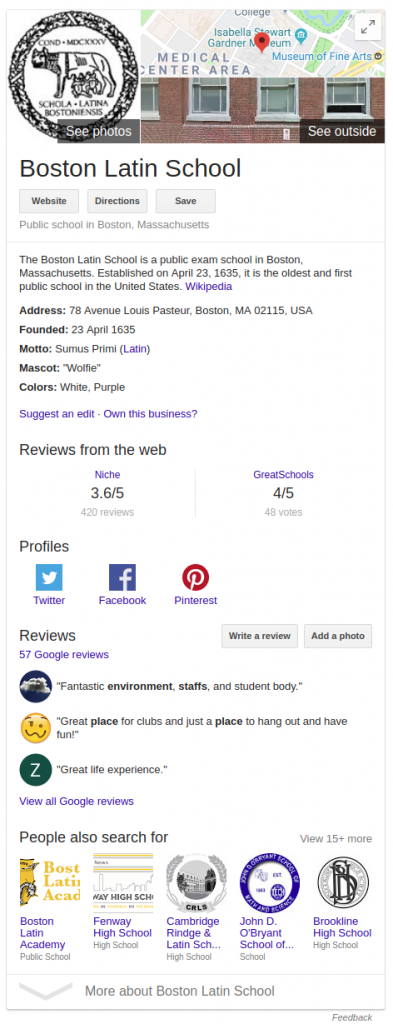
Google is committed to ensuring a flawless experience for all its users by providing the most relevant results as quickly as possible. It took local searches to the next level by proving different types of search results apart from the organic results. If you want to increase admissions at your school, you must not ignore Google.
Today, people also look up to Google for each of their inquiries. So, this could play a prominent role in driving traffic to your school as well. Let’s see what these different types of results are and how do they impact:
Snack Pack
What is a Snack Pack? It’s a pack comprising a local map and 3 local listings. Users can filter these results based on their review.
When does it appear? If a user (student/parent/other) searches for a local business, he will get a “snack pack” result. For instance, if a user searches for “schools in Boston,” he’ll get a snack pack.

What must you do to be there? You must actively build local citations to see your school in a snack pack result because Google lists sites that have local citations. You must also focus on reviews because users prefer those who have good reviews and ratings.
How does it impact? It provides a better search experience to the users by providing the 3 most relevant local listing to the user’s query. Each listing includes the name, category, link to the website, directions and ratings.
Featured Snippet
What is a Featured Snippet? It’s a box containing the answer to the user’s query. The answer could be in the form of a paragraph, list, table or video. It also includes an image, page title and URL of the webpage from where the answer originated. It appears on the top of the search engine result page (SERP).
When does it appear? Featured snippets were designed to offer quick and direct answers, otherwise called rich answers, to the user’s query. For instance, if a user looks for “top schools Boston” or “About Boston School,” he’ll get a rich answer to his query in the form of a snippet that has been featured by Google.

What must you do to be there? To earn a place in Google’s featured snippet, you must get yourself listed in a magazine, listing websites and run outreach programs. You must optimize your website for the search engine with long tail query and targeted keywords, descriptive titles, h1 tags, h2 tags, and write structured content.
How does it impact? It ensures visibility because it positions above the first organic result and could also include multimedia results instead of just text. It not only offers text from metadata but provides highly relevant info to the users. You need not to be in the first position in organic results to have a featured snippet.
People Also Ask (PAA)
What is “People Also Ask?” It’s a box containing a series of questions related to the search term. As a user expands a question, more questions would then be added to the list.
When does it appear? If a user enters a question in the search box for which there can be multiple related questions and a featured snippet is not the only source of information. For example: If a user searches for, “How to apply for admission in a school, Boston?” he’ll get a list of expanded questions that can offer answers.

What must you do to be there? Identify common questions related to your industry and create in-depth content covering those related questions. One of the best ways to provide answers is to have FAQs on your website. Providing answers along with value-added information can help you get featured in PAA.
How does it impact? It helps users find tremendous insights into the topic on the same page, without going anywhere else.
Knowledge Graph Carousel
What is it? It’s a carousel style horizontal slider that displays an image along with the name at the top of SERP. The user can scroll through images by clicking on the arrow. And if the user clicks on an image, he would see details about that particular image in a card called knowledge panel.
When does it appear? Carousel answers queries that have local intent. So, if a user enters a query for a local place in the search box, he’ll get a carousel display. For example: If a user looks for, “high school near Boston, Massachusetts,” Google will respond with a carousel.

What must you do to be there? You must set up Google places, G+ page, optimize images, encourage happy customers to review your business, have citations, and some presence in Wikipedia. This is because it lists those who have various levels of name recognition, reviews and quality of images.
How does it impact? Because it’s horizontal and appears above the organic listing, it does create visibility. The results included in it may not be the same as organic results. But, you need to get listed in organic results to get listed in the carousel.
Knowledge Panel
What is a “Knowledge Panel? It’s a compilation of information gathered from many sources. It’s a box that appears on the right side of SERP. It gives an overview of a particular business. It contains directions, pictures, reviews, social profiles, website, working hours, and key facts related to user’s query.
When does it appear? When a user enters a specific query related to an entity such as a corporation, local establishments, people, movies etc., he’ll get a solid overview of the entity in the form of a knowledge card (knowledge panel). For example: If you search, “Boston Latin School,” you’ll get the figure below.

What must you do to be there? Create profiles on Google’s properties like G+, Maps, YouTube. Get yourself featured in trusted and high-quality sites like Wikipedia. Use schema markup tagging your website elements and create local listings.
How does it impact? It enables your users to discover your business and contact you directly without even visiting the webpage.
You cannot control whether or not you’ll appear in different types of Google results. But, you must try your best to ensure visibility there.
__________________
Varun Bihani is CTO at Examination Online developing custom e-learning and LMS solutions.



















